- "In the midst of hardship, the citizens of Estovakia were convinced that the only way they could recover as a nation was to rely on a military government led by these "Generals". Before long, they went so far as to invade our nation, the Republic of Emmeria."
- ― Melissa Herman[3]
The Emmeria-Estovakia War[4] (エメリア・エストバキア戦争),[5] also referred to as the Estovakia-Emmeria War,[1] was a war on the Anean continent waged between the Federal Republic of Estovakia and the Republic of Emmeria.
Prelude
Ulysses planetfall
In December, 1994, the Ulysses 1994XF04 asteroid was discovered. It was later calculated to enter Earth's Roche limit on July 3, 1999, at which point it would shatter into numerous fragments that would strike the planet.[6] Initially, the estimated range of impact was limited solely to Usea. In response, the Federation of Central Usea (FCU) constructed the Stonehenge railgun network to defend the continent. However, in July, 1998, new data acquired by the International Astronomical Union (IAU) indicated that the asteroid had a hollow interior and would split into two large fragments upon entering the atmosphere, bringing Anea into the estimated range of impact. Stonehenge at this point was already too far in development to be modified, leaving Anea defenseless and sparking continent-wide protests against the FCU and IAU.[7]
This left the Anean nations with only a year to prepare for the coming impact. Emmeria evacuated the areas most likely to be struck by the asteroid and constructed numerous underground bunkers around their capital, Gracemeria, capable of carrying up to 200,000 people.[8] Estovakia opted to create their own asteroid interception weapon, Chandelier. However, limited time resulted in the railgun not being completed in time.[9]
On July 3, 1999, Ulysses entered the Earth's atmosphere and shattered into thousands of pieces. For five full days, the fragments would rain down on the surface below. The impacts saw the collapse of both Emmeria and Estovakia's economies. Despite this, Emmeria was able to recover relatively quickly while Estovakia suffered the brunt of the damage. In an effort to aid its eastern neighbor in its recovery, Emmeria began the Emmerian-Estovakian Reconstruction Effort.[10]
The lack of government presence following the impacts saw the rise of numerous factions across Estovakia, all vying for control of the nation.[11] In April, 2007, one faction, the Lyes United Front (LUF) managed to take control in of the former Estovakian capital, located in the western part of the country. Emmeria, still continuing its aid program, was unaware that the LUF blocking supply routes and using the aid to improve their military capabilities. As a result, humanitarian aid which was meant for the city of Gledina, never arrived, resulting in the deaths of over 200,000 civilians. Following this, the Eastern Faction declared war on the LUF, sparking the Estovakian Civil War. Shortly afterwards, the other factions–the Independent Tariff Federation, Northern Highlands Faction and Island Coalition–all declared war on each other.[10]
Estovakian Civil War
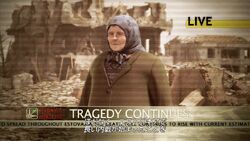
An Estovakian survivor of the Ulysses impacts
The war remained in a stalemate until Belkan Federation engineers led by former Gault Squadron pilot Lorenz Riedel joined the Eastern Faction, providing them with classified research on heavy command cruiser aircraft technology. The leaked designs were adapted into an "Aerial Fleet Initiative" by Eastern Faction commander Gustav Dvornik, and upon battlefield deployment allowed Estovakia to obtain air superiority across the country, leading to the eventual defeat of the Lyes United Front at west Estovakia in 2013.[12]
After the end of the war, the Eastern Faction formed a new federal government, staffed by former faction soldiers and headed by The Generals, a military junta formed by Eastern Faction commander Gustav Dvornik and five officers from the Estovakian armed forces. Their administration was impaired by a resistance movement from anti-Eastern Faction insurrectionists and Lyes United Front loyalists, which launched repeated attacks against the new directors.[13]
War veterans and politicians publicly expressed their discontent at Emmeria, accusing them of contributing to the civil war through the unabated humanitarian aid to the Lyes Front. The anti-Emmerian sentiment continued to grow after the death of Minister Isaac Arensky and a propaganda campaign by the Generals, who declared that a strict and authoritarian military dictatorship was necessary for Estovakia to recover its former stability.[13]
The war
Outbreak of war

An F-15E over an Emmerian Navy fleet
The hatred against Emmeria led the Generals to order a military invasion of Emmeria in mid-2015 as retribution for their perceived role in the civil war. Junta member Gustav Dvornik was appointed as Expeditionary Forces General, becoming the supreme commander of the army group involved in the operation.
In August 30 of 2015, a strike force formed by fighter aircraft, parachute-dropped armored vehicles and the Aerial Fleet's P-1112 Aigaion launched an attack on the Emmerian capital of Gracemeria. The Emmerian Air Force and ground army intercepted and repelled the initial invasion force, but suffered heavy losses due to Nimbus missile attacks from the Aigaion and the Strigon Team.
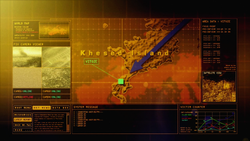
A report of the Emmerian retreat
Unprepared to deal with the offensive, the Emmerian government ordered an strategic evacuation of Gracemeria, leading its military and populace to stage a mass exodus towards west Emmeria and Khesed Island. Many troops failed to escape and were annihilated or stranded on the mainland, while those who fled to Khesed fought their way through a naval cordon set up by the Estovakian Navy.[14] By late October, most of Emmeria had fallen under Estovakian control.[4] The survivors of Dvornik's offensive established themselves at the city of Vitoze in southern Khesed, serving as the last major bastion of Emmerian resistance. The Estovakian army continued their pursuit of the Emmerian troops and set up two major bases on the island; a forward base on the city of Misko in Sipli Field and a central headquarters, Bartolomeo Fortress, located on Mount Marcello in northern Khesed. In November 24, the Estovakian Air Force staged a bombing attack on Vitoze that was repelled by the Emmerian military, leading to a weakening of their air power in the region.
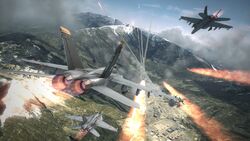
Avalanche Squadron during the Battle of Bartolomeo Fortress
Three days later, the Emmerians launched an offensive on Sipli Field and liberated Misko from Estovakian control, using the momentum gained from the attack to expel them from central Khesed and force them into the vicinity of Bartolomeo. A month later, the Emmerian army launched a siege on Mount Marcello, beheading the leadership of the local Estovakian forces and eradicating their presence on Khesed Island, as well as marking the first combat deaths of the Strigon Team during the war at the hands of the Garuda Team. Their actions were closely monitored by former Gracemerian DJ Zed Waters and his crew, who relayed news of their advances to the Emmerian people through the Freedom Fighter, a customized radio van.
Emmerian counterattack
With the liberation of Khesed Island, the Emmerian military began preparations for a campaign to establish a foothold in the Anean mainland to reclaim Emmeria from the Estovakian military. After amassing enough troops and intelligence for the effort, a joint amphibious landing operation was carried out on the Jamel Desert in western Anea on January 26 of 2016, leading them to create their base of operations on the mainland. Over the next weeks, the Emmerian armed forces began a rapid eastward push, forcing back the Estovakian army and rescuing fellow troops left behind during the evacuation to Khesed. Garuda's increasing fame led the Strigon Team to be repeatedly deployed in special operations to kill Talisman, all of which ended in failure.
By mid-February, the Emmerian military's areas of operation reached as far as central Anea, increasing the strain of the Estovakian military and leading to the deployment of the Aigaion to directly participate in combat. On February 12, during a mission to move ground forces through the Selumna Peak, it attacked Emmerian troops with a barrage of Nimbus missiles aimed by Searcher "marker drones", causing major damage before they were shot down by Garuda. In response, the Emmerian Joint Chiefs of Staff deemed the destruction of the Aerial Fleet one of their main objectives prior to the liberation of Gracemeria, leading to the capture of San Loma three days after as a base for an assault on the fleet.
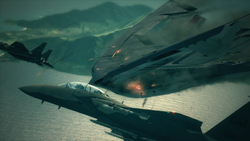
Garuda Team watching the Aigaion fall
After extensive intelligence acquisition, a strike force led by Garuda Team ambushed the Aigaion and her aerial fleet over the Fuscum Sea south of Anea. The battle resulted in a majority of the original Strigon Team members being shot down and the entire aerial fleet being shot down. The man behind the aerial fleet, Lorenz Riedel, was also shot down during the battle..
Stovies on the defensive
With the loss of Estovakia's proud Aerial Fleet, the remaining Estovakian forces occupying the rest of Emmeria was forced on the defensive. The full might of the Emmerian military raced for the remaining regions under the invaders' control, with the capital Gracemeria as the prize and Garuda Team as the spearhead of the offensive.
In early March, Emmerian ground and air forces launched an attack on Ragno Fortress in Central Anea, around Grageo Canyon. Combined arms from Emmerian tank battalions and fighter squadrons broke the center of the fortress's garrison, paving the way for a direct assault inside the fortress. Meanwhile, other air units attacked logistics lanes along the canyon river by the dam, as well as tunnels where the Estovakians keep their military hardware. With the help of Emmerian special forces units assaulting the fortress from the inside, the Emmerians retook the fortress and opened the gate straight to Gracemeria.
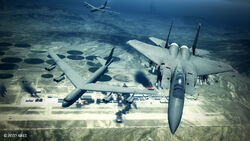
Garuda Team with Hammerhead Squadron during the Battle of the Moloch Desert
By late March, the Estovakians were outnumbered. Much of their military strength had been lost in defeat after defeat since Vitoze. The Estovakians gathered as many troops as they could to make a last stand at the Moloch Desert, but were defeated nonetheless. Just as when victory was near, Emmerian commanders ordered the withdrawal of all Emmerian forces from the desert for an unknown reason. Shamrock, who had desperately wanting to liberate his beloved home, disobeyed the order to withdraw and attacked the flight of Strigon Team planes entering the airspace. Unable to leave his wingman behind, Talisman joined in the fight. A later debriefing revealed that Estovakians were prepared to level Gracemeria with weapons of mass destruction had the Emmerians come any closer. Garuda Team was grounded for their insubordination.
A day after the Moloch offensive, however, Emmerian commanders were forced to call upon Garuda Team again to strike at Fort Norton, where the said weapons of mass destruction were being hidden. Their skill, which had helped the Emmerians fight through insurmountable odds, was necessary to carry out the strike. They flew in at low altitude to avoid detection by enemy radar and successfully destroyed the WMD carriers. As they fled the area, Garuda Team was trapped by squadrons of Estovakian aircraft, clearly angry about foiling their "scorched earth" plans. Fortunately, Emmerian air units arrived just in time to assist.
Operation Free Gracemeria and conclusion
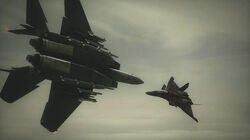
Talisman facing off against the Strigon Leader
On March 31, 2016, Emmerian forces initiated Operation Free Gracemeria with the main objective of retaking the capital. Again, the remnants of Estovakian forces in Emmeria gathered in the city to thwart the offensive; but even with the late arrival of Strigon leader Ilya Pasternak, flying a CFA-44 Nosferatu along with more or less 40 UAVs, the Emmerians succeeded in taking their capital back.
That night, a grand celebration was held, with Emmerian fighters patrolling the skies. But the celebration was cut short by an air raid siren. Cruise missiles were detected entering the airspace, along with stealth fighters. The patrolling squadrons, along with anti-air ground batteries, blunted the surprise attack.
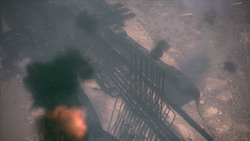
A battle ensues around the Chandelier
After realizing the existence of the Chandelier railgun system near Sonne Island, Emmerian commanders realized that Gracemeria could never be truly safe until the railgun is destroyed. On April, Emmerian fighter squadrons descended on the Chandelier to put an end to the destruction it could cause. With the help of an Estovakian Air Force officer who transmitted data regarding the Chandelier's cooling units, the Emmerians destroyed Estovakia's last chance for a turnaround. One of The Generals, Gustav Dvornik, was reportedly killed in action trying to escape a crumbling Chandelier.
In the closing days of the war, The Generals were overthrown by a coup d'etat. A peace treaty was signed by both countries, effectively ending the war.
References
- ↑ 1.0 1.1 Ace Combat 6: Fires of Liberation Assault Records #27 - Gustav Dvornik.
- ↑ Campaign -> Gallery -> Scene Viewer -> Scene 17, "A Brand New Day", Ace Combat 6: Fires of Liberation.
- ↑ Cutscene following Invasion of Gracemeria, Ace Combat 6: Fires of Liberation.
- ↑ 4.0 4.1 FRONT LINE Special Issue: The Aerial Fleet.
- ↑ Acepedia [@AceCombatWiki] (13 June 2018). "Here are the highest-quality scans from the #AceCombat section of the new Weekly Famitsu, courtesy of Tumblr user famigeki!". Twitter.
- ↑ "President Makes Announcement To Ambassadors And Their Respective Nations", Usea Today: Asteroid on Collision Course With Earth!. Retrieved June 29, 2018.
- ↑ "Wider Damage Range than Estimated", GAZE: Last Christmas. Retrieved June 29, 2018.
- ↑ "A Shelterized Castle", GAZE: Last Christmas. Retrieved June 29, 2018.
- ↑ Chandelier, Ace Combat 6: Fires of Liberation.
- ↑ 10.0 10.1 The Emmerian Chronicle
- ↑ Ace Combat 6: Fires of Liberation Cutscene #02: Realization.
- ↑ Ace Combat 6: Fires of Liberation Complete Guide
- ↑ 13.0 13.1 Cite error: Invalid
<ref>tag; no text was provided for refs namedEmmeriaNews - ↑ Ace Combat 6: Fires of Liberation - Emmerian Assault Records
